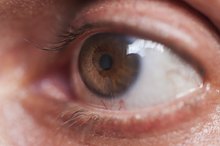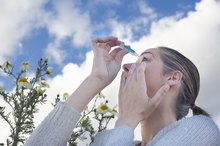Caffeine & Eye Pressure
Caffeine does more than just boost energy levels. It can also increase pressure within the eye. This is concerning, because high eye pressure over time can lead to glaucoma, a potentially blinding disease of the optic nerve. Whether or not this pressure increase will have long term visual effects depends largely on a person’s genetics and family history of glaucoma. (see references 1 & 2)
Caffeine Consumption
Caffeine is a major component of commonly consumed beverages such as coffee, tea and soda and is found in foods such as chocolate candy or cake. (see reference 3) Just one cup of coffee (approximately 230ml) contains 150 to 180mg of caffeine (see references 1 & 3). It is estimated that individuals consume over 200mg of caffeine daily in the United States and over 400mg a day in Europe. (see reference 3) One study published in Eye showed that after 60 minutes of ingesting 1 cup of caffeinated coffee, the intraocular pressure increased by 1 mmHg. The majority of the study participants were Caucasian and ranged in age from 40 to 80 years old. (see reference 1)
- Caffeine is a major component of commonly consumed beverages such as coffee, tea and soda and is found in foods such as chocolate candy or cake.
- ( It is estimated that individuals consume over 200mg of caffeine daily in the United States and over 400mg a day in Europe.
- (
Mechanism of Action
Does Caffeine Cause Blood Clots?
Learn More
Caffeine elevates intraocular pressure in several ways. It directly increases production of aqueous humor, the fluid that fills the front part of the eye. Increases in this fluid increase the eye pressure. Caffeine also decreases smooth muscle tone. This slows down the rate at which aqueous humor is filtered out of the eye. Further, aqueous fluid formation is also stimulated through caffeine’s blood pressure- elevating effects. However, for every 1 mm Hg increase in eye pressure that caffeine produces, there is an equal 1mm Hg increase in ocular perfusion pressure, or the rate at which aqueous is released from the eye. This, in effect, negates the pressure increase ( see references 1 +2)
- Caffeine elevates intraocular pressure in several ways.
- Further, aqueous fluid formation is also stimulated through caffeine’s blood pressure- elevating effects.
Glaucoma Risk
Primary open angle glaucoma (POAG) is a disease whereby the optic nerve is slowly damaged over time. It is a major cause of blindness throughout the world. Studies on caffeine effects have shown that people with naturally higher eye pressure showed a higher elevation in their eye pressure with caffeine ingestion. West Africans who have a genetic predisposition to developing glaucoma, had higher transient eye pressure spikes at lower levels of caffeine (30-50mg). Another study reviewed the effects of caffeine through food/drink consumption over a twenty year period. It found that although caffeine itself is not associated with glaucoma risk, it did increase the risk among people with a family history of glaucoma. (see reference 2)
- Primary open angle glaucoma (POAG) is a disease whereby the optic nerve is slowly damaged over time.
- Studies on caffeine effects have shown that people with naturally higher eye pressure showed a higher elevation in their eye pressure with caffeine ingestion.
Lifestyle Modification
L-Arginine and Glaucoma
Learn More
Because high intraocular pressure is a major risk factor for the development of glaucoma, understanding what causes eye pressure to rise is key in lowering the chances of developing this disease. Halting coffee or tea consumption would be an easily modifiable lifestyle choice if doing so lowers glaucoma risk. However, based on study results so far, further investigation is needed regarding how a person’s genetics, family history and race may play a role in how their eye pressure responds to caffeine. If you have a family history of glaucoma or you have high eye pressure, you should visit with your ophthalmologist to discuss your caffeine use and potential risk of developing glaucoma. (see references 1 & 2)
- Because high intraocular pressure is a major risk factor for the development of glaucoma, understanding what causes eye pressure to rise is key in lowering the chances of developing this disease.
- However, based on study results so far, further investigation is needed regarding how a person’s genetics, family history and race may play a role in how their eye pressure responds to caffeine.
Related Articles
References
- Eye: Effects of Caffeinated Coffee Consumption on Intraocular Pressure, Ocular Perfusion Pressure, and Ocular Pulse Amplitude: A Randomized Controlled Trial
- Investigative Ophthalmology & Visual Science: Caffeine Consumption and the Risk of Primary Open-Angle Glaucoma: A Prospective Cohort Study
- Journal of Clinical Ophthalmology: Effect of Caffeine on the Intraocular Pressure in Patients with Primary Open Angle Glaucoma
- Meredith SE, Juliano LM, Hughes JR, Griffiths RR. Caffeine Use Disorder: A Comprehensive Review and Research Agenda. J Caffeine Res. 2013;3(3):114-130. doi:10.1089/jcr.2013.0016
- Richards G, Smith AP. A Review of Energy Drinks and Mental Health, with a Focus on Stress, Anxiety, and Depression. J Caffeine Res. 2016;6(2):49-63. doi:10.1089/jcr.2015.0033
- Brunyé TT, Mahoney CR, Rapp DN, Ditman T, Taylor HA. Caffeine enhances real-world language processing: evidence from a proofreading task. J Exp Psychol Appl. 2012;18(1):95-108. doi:10.1037/a0025851
- Koppelstaetter F, Poeppel TD, Siedentopf CM, et al. Caffeine and cognition in functional magnetic resonance imaging. J Alzheimers Dis. 2010;20 Suppl 1:S71-84. doi:10.3233/JAD-2010-1417
- Harrell PT, Juliano LM. Caffeine expectancies influence the subjective and behavioral effects of caffeine. Psychopharmacology (Berl). 2009;207(2):335-42. doi:10.1007/s00213-009-1658-5
- Lucas M, O'reilly EJ, Pan A, et al. Coffee, caffeine, and risk of completed suicide: results from three prospective cohorts of American adults. World J Biol Psychiatry. 2014;15(5):377-86. doi:10.3109/15622975.2013.795243
- Abdel-Hady H, Nasef N, Shabaan AE, Nour I. Caffeine therapy in preterm infants. World J Clin Pediatr. 2015;4(4):81-93. doi:10.5409/wjcp.v4.i4.81
- American Psychiatric Association. Diagnostic and Statistical Manual of Mental Disorders. 5th edition. Washington DC; 2013.
- Turnbull D, Rodricks JV, Mariano GF, Chowdhury F. Caffeine and cardiovascular health. Regul Toxicol Pharmacol. 2017;89:165-185. doi:10.1016/j.yrtph.2017.07.025
- Centers for Disease Control and Prevention. Alcohol and Caffeine. Updated October 23, 2018.
- Alsunni AA. Energy Drink Consumption: Beneficial and Adverse Health Effects. Int J Health Sci (Qassim). 2015;9(4):468-474.
- Lyngsø J, Ramlau-Hansen CH, Bay B, Ingerslev HJ, Hulman A, Kesmodel US. Association between coffee or caffeine consumption and fecundity and fertility: a systematic review and dose-response meta-analysis. Clin Epidemiol. 2017;9:699-719. doi:10.2147/CLEP.S146496
- U.S. Food and Drug Administration. Pure and Highly Concentrated Caffeine. Updated September 21, 2018.
- National Institute on Drug Abuse. Drugs, Brains, and Behavior: The Science of Addiction. Updated July 2018.
Writer Bio
Kate Beck started writing for online publications in 2005. She worked as a certified ophthalmic technician for 10 years before returning to school to earn a Masters of Fine Arts degree in writing. Beck is currently putting the finishing touches on a novel.









